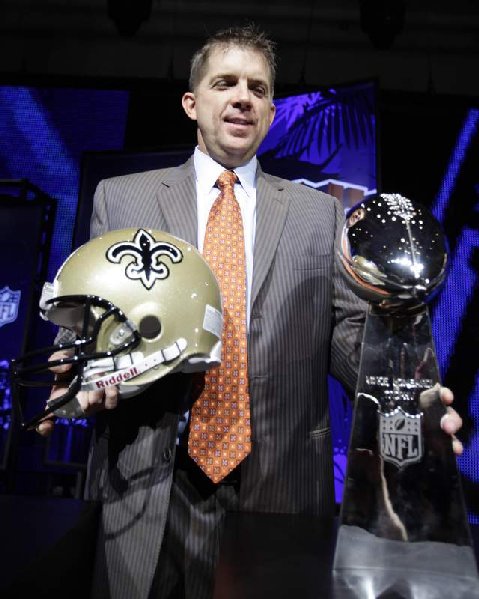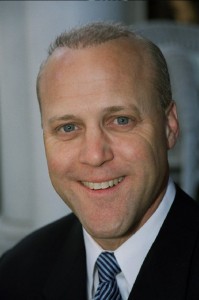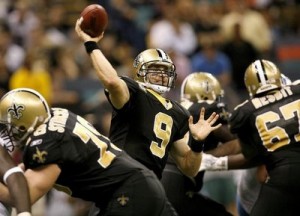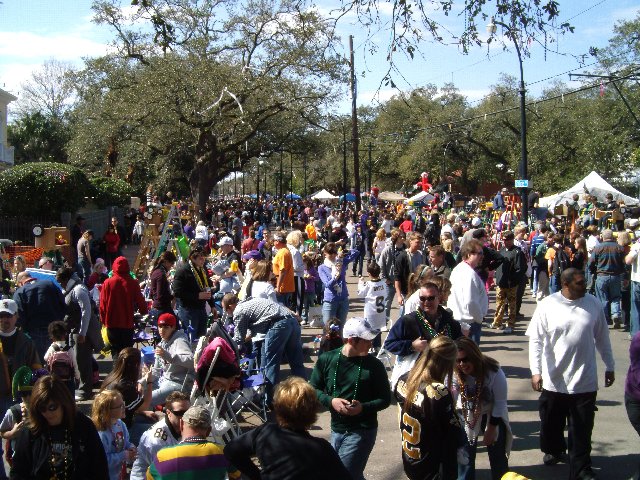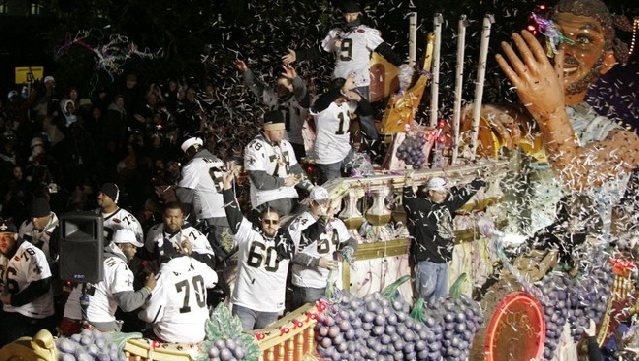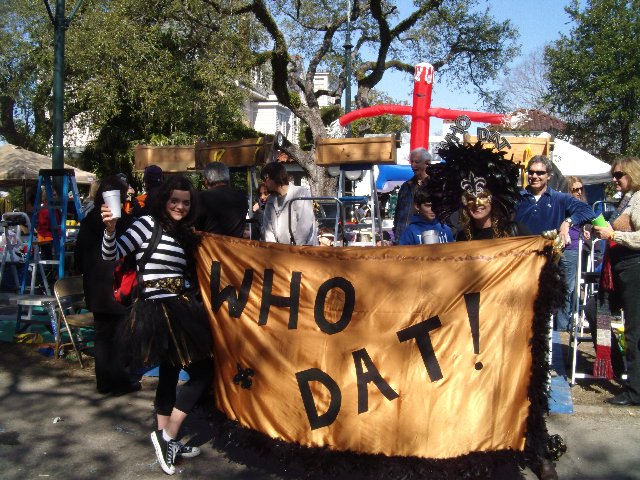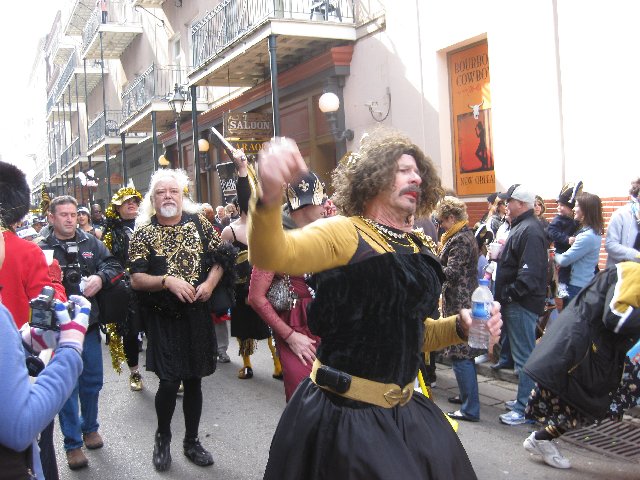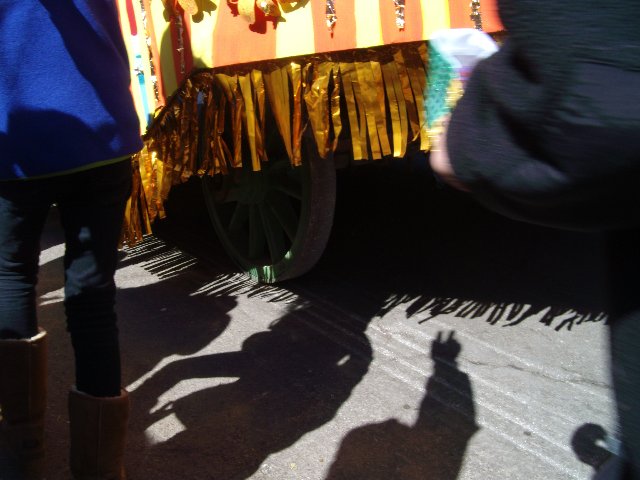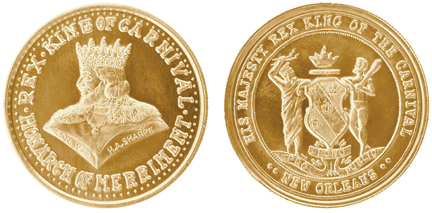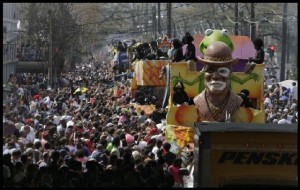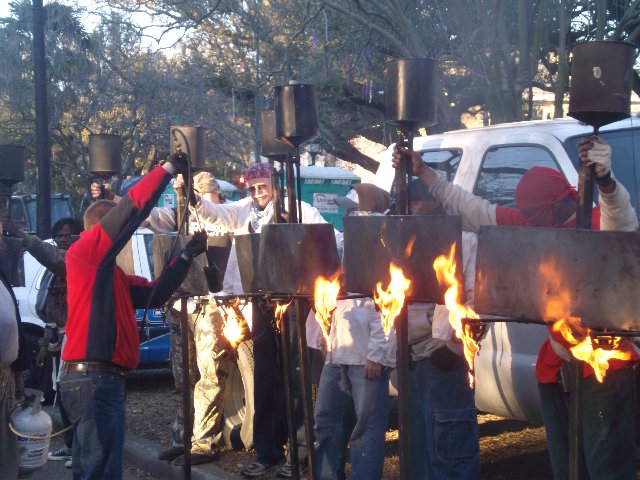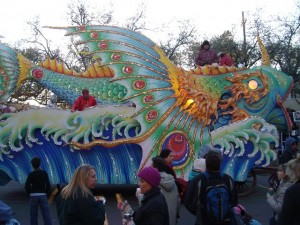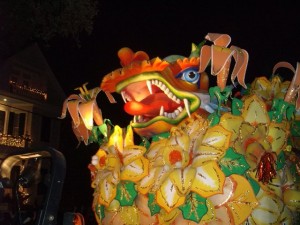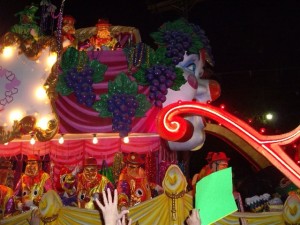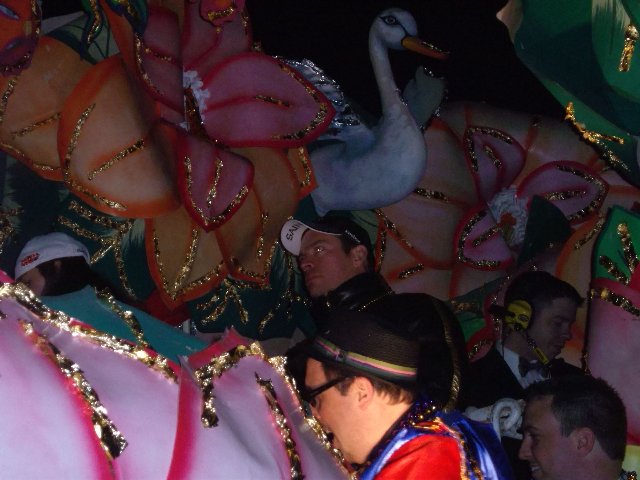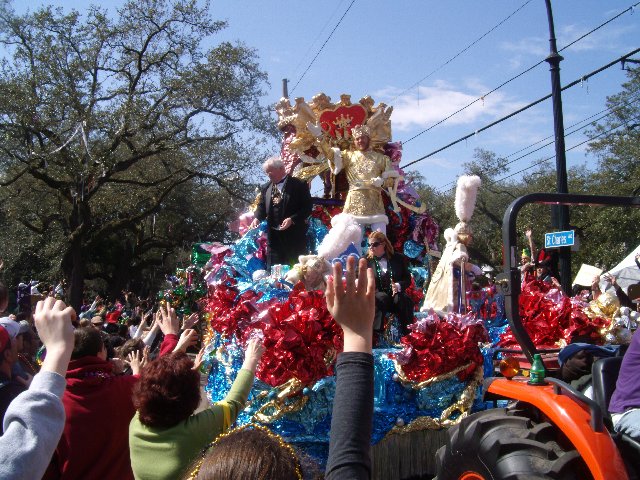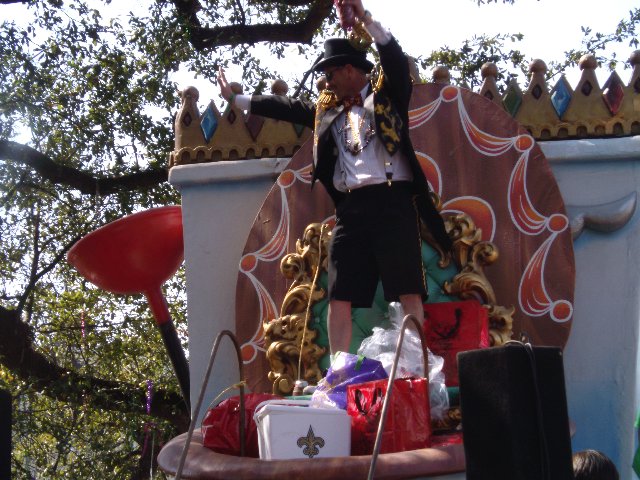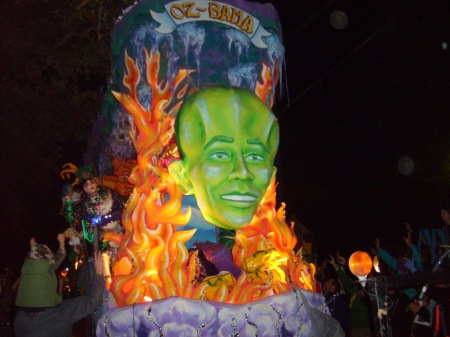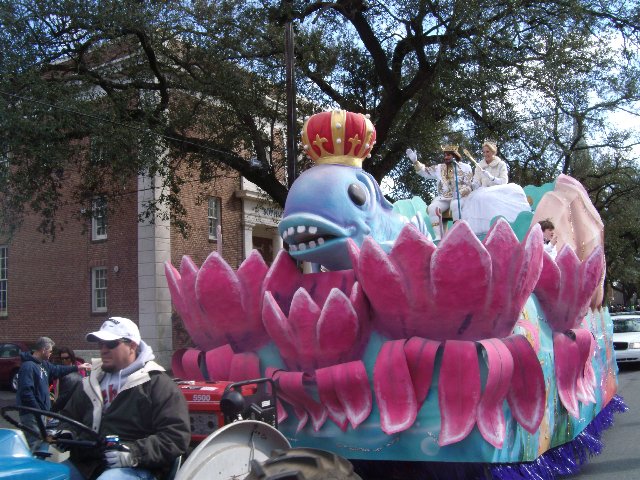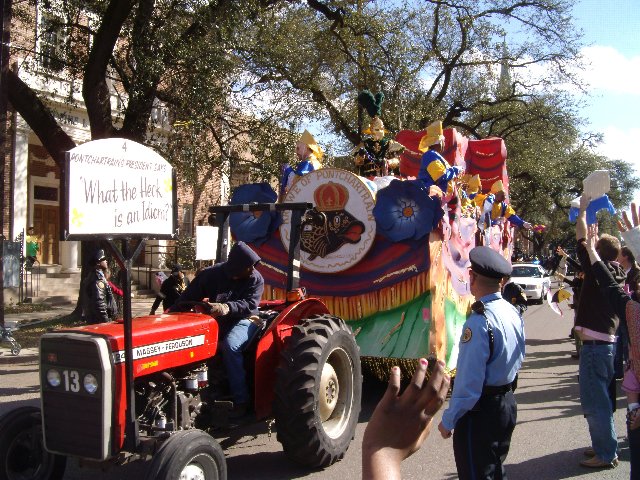Posts tagged Doubloon
2010 Mardi Gras Parade Review: Who Dat Nation meets Mardi Gras!
02010 was among the most unique Mardi Gras on record. As Twelfth Night passed, the 2010 Carnival Season began and the Saints wound their way through the NFL playoffs. It became a real possibility that our local pro football team might end up in the Big Game. As it happened, the Saints WON Super Bowl XLIV 30-17, during Carnival 2010, handily beating the favored Indianapolis Colts, led by favorite athletic son Peyton Manning.
Meanwhile, a very important Mayor’s election occurred the day before the Super Bowl, and favorite son Mitch Landrieu received 67% of the vote, and avoided the usual runoff when all the candidates get below 50%. 67% is huge win by any stretch of the imagination. So the Super Bowl win occurred during Carnival, and the new Mayor was voted in a landslide, which rarely occurs in the fractured politics of New Orleans. Landrieu is the first white Mayor of New Orleans since his father in the 1970s.
The crowd on St. Charles for Bacchus and several other parades now rivals the Fat Tuesday crowd. Okeanos, Mid-City and Thoth all roll around late morning-early afternoon. Bacchus rolls at 5:15, and easily takes three hours to pass, ending around 8:30 pm. Minimal time on St. Charles, assuming all parades are attended, is 9 hours. Mardi Gras Day on St. Charles ends after the trucks pass, around 3 pm. Rex passes around 11 am. Total time parading on St. Charles above Jackson is 4-5 hours. Below Jackson add Zulu to the total hours, now 6.5 hours. Fat Tuesday, the culmination of the Carnival Season, always has been the big day for parades. Now, Bacchus Sunday is far longer. The consolidation of neighborhood parade routes plus the desire of Krewes to roll on the weekend has caused this.
2010 saw inclement weather shift the parade schedule. Chaos cancelled, Babylon became a day parade, and Muses followed three other parades. Rescheduling means most of a parade’s bands can’t make it. Other parades changed days, changed starting times, and one canceled because of the Super Bowl.
Another less positive parade trend came to the fore during Carnival 2010- parades passing in under 2 hours! One major parade will all its units passed in under one hour! Up to last year, parades almost always took a leisurely three hours on average. What’s the rush? If a parade has rescheduled, up to half the parade’s units may be lost, shortening a parade accordingly.
Many float riders don’t keep their masks on. This trend has been creeping into Mardi Gras for several years. Of course the ‘rules’ say masking is mandatory but who enforces that kind for rule in the make believe Carnival world?
There was a nationally televised Super Bowl Victory Parade for the Saints, carried live on CNN, ESPN, and all local network affiliates, also occurring during Carnival. Good Morning America shot from New Orleans before the Super Bowl. The French Quarter erupted into a Mardi Gras Day sized party, this time a Black & Gold party, immediately after the Super Bowl victory. The Saints Players interacted with the crowd to a much larger extent than in Mardi Gras parades. Many folks who attended the Saints Super Bowl Parade say it was the greatest parade experience of their lives. It created a giant traffic jam as tens of thousands of the Who Dat Nation from all over the region clogged the ferries & highways, attempting to reach the parade. Many in the traffic jam never made it, turning around after sitting in traffic for a couple of hours.
All throughout the Mardi Gras Season, including Fat Tuesday, Black & Gold Saints Gear & Costumes were worn to an incredible extent. People who never costume wore extensive Saints Gear & Black/Gold Costumes. Tons of black & gold fleur de lis beads, black & gold footballs & beads, I Believe hand towels, etc. were tossed off the floats. By the time the Saints made it to the Super Bowl, all the Mardi Gras stores were long out of Saints stuff.
Another Saints related parade took place during Carnival 2010-A large number of men paraded in dresses to honor the late Buddy Diliberto’s pledge to wear one if the New Orleans Saints made it to the Super Bowl.
No review of Carnival 2010 would be complete without a salute to the Who Dat Nation! Who is the Who Dat Nation? Any enthusiastic Saints fan. Who Dat has been the rallying cry of the Saints for years. Taken from a line in a popular local Saints tune, Who Dat Say Gonna Beat Dem Saints? Who Dat? Who Dat? The national media picked up the over the top frenzy that Saints fans feel about their now winning team. During Good Morning America’s coverage of the Super Bowl, they did a split screen with a group of fans in each team’s city. The contrast between the wild, black & gold Who Dat Nation fans from New Orleans, jumping in the air and dancing with Kermit Ruffins playing in the forefront, next to the staid, laid back Indianapolis fans, was startling. Super Bowl XLIV was the highest rated TV program ever. Why was this game so popular? The obvious reason is the Who Dat Nation grew beyond the Superdome, beyond the New Orleans region into a national/international Football phenomena the scale of which only became apparent when the TV ratings for the Super Bowl came in. The top rated TV program ever means the Who Dat Nation may be the biggest NFL fan club ever!
More important than the top TV show ever is the unseen and unexpected effect the Super Bowl, Mardi Gras, Who Dat Nation, and the New Orleans election had on the national and international persona of New Orleans. 4 1/2 years post Katrina, the Crescent City was seen as a dangerous, needy, unique American City, and many visitors stayed away. The triple whammies of 9/11, Katrina/Rita, plus the recession had forced the tourist business on life support.
The positive PR from the incredible media coverage changed the image of New Orleans from Katrina ‘losers’ with our hands perpetually out, to magnanimous, safe, fun loving winners! The Who Dat Nation had corrected the Katrina Curse and righted NOLA’s reputation. This is a complex equation involving American Public Opinion, no easy thing to influence. The fact is, no one predicted this opinion shift, it couldn’t be forecast, all the right factors came together unexpectedly. God Bless America!
REX– The throw world is very competitive. Krewes strive to come up a novel throw each year. Rex is not immune to these pressures, as they have expanded their throws considerably in quality and quantity over the last few years. They threw two sizes of three colors of Rex Lieutenant Plush- purple, green & gold dolls- all high quality, like all their plush. They threw two sizes of plush white boeuf gras, a giant plush crown, and a nice purple, green & gold REX kerchief.
Rex is a Super Krewe that runs on cotton wagon chassis with wooden wheels from the 19th century.
Rex also threw a heavy gold replica of their original doubloon, to celebrate their role in bringing the doubloon to Mardi Gras. 50 years ago, Alvin Sharpe approached the Rex Captain and showed him the first prototype for a mass produced doubloon. The Captain was concerned about the risk to parade attendees when showered with doubloons. Sharpe took a handful of prototypes and threw at the Rex Captain. He was of course unhurt and that closed the deal for Mr. Alvin Sharpe.
Rex also played the green card. Each Rex cup has the recycling symbol, plus reuse, recycle, degradable and giacona.com. According to giacona.com, the degradable cups have plastic resin additive allows microbes to ingest and break down in landfill. Made in USA – lower carbon footprint than imported products. Made of FDA Approved material. In the opinion of this blog, this is a serious step up for Rex and the green movement within the Carnival World. Rex had another green claim, this one not nearly as serious a green step. The Rex beads’ strings are degradable also. When Rex beads get stuck in a tree, now the sunlight will degrade the string, and all the beads will fall to the street. Where are degradable beads?
Zulu– Zulu ran on time for the first time in memory, and moved so briskly down Jackson Avenue it was amazing. Zulu is a one of kind parade with great bands like the U.S. Marine Marching Band & St. Augustine Marching 100, plus great groups like the Budweiser Clydesdale Horses. They have the original handmade throw, the famed Zulu Coconut.
Proteus– Proteus entered the modern age of throws with its first Light Up Bead, a jelly like seahorse containing three red LED lights. The floats were build on cotton wagon wooden chassis with wooden wheels, very similar to the chassis REX rolls on. Royal Artists builds Proteus in the old fashioned way, giving them a look of Carnival long ago. The flambeaux are the original model, also from the 19th Century. Proteus had some of the finest looking floats of the season.
Orpheus- Orpheus had its leader, Harry Connick, Jr. on his float this year, since the Saints won the Super Bowl he’s been in New Orleans. Super Bowl Champ Saints Head Coach, Sean Payton had his own float in Orpheus. We caught a 2.5 inch 2010 Snooks Eaglin Doubloon from a Orpheus Officer. Orpheus floats are brashy, very large, with a number of annual super floats- three part Leviathan Dragon, Trojan Horse, six part Smokey Mary Train and more. Orpheus doesn’t lack for music, as the krewe was co-founded by NOLA born Harry Connick, Jr.
Bacchus– Bacchus is the original Super Krewe, the first to feature major Celebrity Kings, the first with multi-unit floats, etc. Their annual Super floats- Kong Series, Bacchusauras, & Baccawoppa, etc. are icon Super Floats and the model for Super Floats all over Carnival parades.
Thoth– Thoth used the same green cup base as Rex with their own design and get the same credit for going green with a throw that’s abundant. From the unfinished Thoth web site: because it designs its parade route to pass in front of 14 institutions that care for persons with disabilities and illnesses, the men of Thoth have become known as the “Krewe of the Shut Ins”. Thoth spends their money on throws, as they go past all those institutions before turning on St. Charles and joining the traditional route. This is Thoth’s 63 Anniversary and one of the larger krewes with over 1,200 members.
Mid-City- Known for the brightly colored aluminum foil Mid-City uses to cover its floats, Mid-City was formed in 1933 and is the fifth oldest continuously parading krewe. 2010 was sunny, so the foil floats were shown to their best effect. Mid-City holds a band contest among bands that parade with them. For 2010, we counted six Memphis, Tennessee High School Marching Bands in Mid-City, which we found very interesting. All those buses, accommodations, and feeding necessary for that many teenagers is quite a logistics job, aside from running a major Mardi Gras parade and ball. My Mardi Gras hat is tipped to the Krewe of Mid-City for getting all those Memphis kids down here and back.
Okeanos– Okeanos had a very big crowd this year, as part of the huge Bacchus Sunday on St. Charles Avenue. They usually start off Sunday, but were preceded this year by the Knights of Babylon, who moved to Sunday after inclement weather moved them from their original date of Thursday, February 11. Okeanos is another old krewe, this is their 60th year of parading.
Babylon- Babylon is designed by the fabulous Henri Schindler, who preserves the old paper mache float building techniques from long ago. Babylon was founded in 1939 and has expanded its throw repertoire substantially- they threw Babylon backpacks, jester heads & hats, and a Light Up bead as well. This krewe lost a good number of bands because of scheduling problems due to their original date rain out. Babylon is a night parade lighted by flambeaux that ran in bright sunshine, obviously without their flambeaux.
Endymion- Endymion is the biggest of all Mardi Gras Krewes with over 2,400 members. Endymion does it just a little bit better than everyone else. Endymion didn’t have the Saints Quarterback or Coach, but the Saints Owner Tom Benson and his wife Gayle as Grand Marshalls. Endymion is the only parade that rolls through Mid City and down Canal Street. The crowds for Endymion are positively huge. Endymion has some annual special Super Floats, such as Captain Eddie’s SS Endymion Steamboat. The Budweiser Clydesdale Horses and The St. Augustine Purple Knights were featured in the parade, along with more than two dozen other Marching Bands.
Tucks– Tucks was formed by a few college students a few decades ago, and they have never lost their sophomoric potty humor- their King sits atop a giant toilet! One of their most popular throws each year is a small toilet that squirts water. Tucks is the only krewe to throw toilet paper with their logo on each sheet. Their Friar Tuck stuffed dolls (as opposed to ‘plush’ dolls) remain an icon Tucks throw and they always throw wooden nickels. Tucks is a satirical krewe that loves to tell City Government that they really could do a better job.
Iris- Iris is the oldest all female krewe in New Orleans, as they formed in 1917, but didn’t parade until 1959. It’s a fairly large krewe, with around 800+ riders. Iris allows some men to ride on their floats, which is OK with me! Iris is a generous krewe who puts some money into their costumes. There used to be Venus, another Orleans parading women’s krewe, and there used to be Shangri-La, another large female from St. Bernard Parish that ended up on St. Charles Avenue before ending their big parade, and morphing into a French Quarter Buggy parade. That leaves Iris and Muses as the only female krewes still parading down St. Charles.
Muses- Muses didn’t disappoint in 2010, their 10th anniversary, tossing their usual unbelievable assortment of throws with their logo on them. Here’s very close to a complete list of Krewe 2010 throws: Shoe Bracelet, Muses Ivy Bead, Seed Glass Beads, Shoe Bead, Strobe Theme Bead, Shoe Necklace, Disco Ball Necklace, Flashlight Bottle Opener, Historic Shoe Bead, Acrylic Light Up Shoe Necklace, Diamond Ring, Puffy Key Ring, Muses 10 Ball, Sleep Mask, Glitter Frisbee, Can Koozie, Glitter Heart Tattoo, Leather Rhinestone Bracelet, Re-Usable Tote Bag, Plush Cupid Arrow, Muses Plush Assortment, Cloisonne Doubloon, Patterned Bead Bag, Mini Patterned Bead Bag.
Name another krewe that throws half that much stuff with their logo on it. Muses sells nothing to their membership without their ‘M’ on it. Muses has several signature floats, including The Shoe, The Sirens, and The Bathtub. The only all female nighttime parading organization, their feminine influence is obvious throughout the parade. Since Muses had to reschedule due to bad weather, some of their many bands couldn’t accompany them. Muses is one of the largest krewes to parade down St. Charles Avenue, with more than 1,000 members.
Muses sets the standard with wacko marching groups (except for KdV) with such groups as The Pussy Footers, Muff-a-Lottas, 610 Stompers, and Camel Toe Lady Steppers.
Morpheus– Morpheus is a krewe on the move. Over the last few years, Morpheus has grown from a small krewe to a mid-sized krewe, and in this economy post Katrina that is not an easy thing to do. Krewe dissolution and parade cancellation seems to occur more often.
D’Etat– D’tat has been around 15 years, and in that time they have carved themselves a niche in storied Mardi Gras Krewe History. They won Throw of the Year Honors from us last year for their functional Super Throw, the large, full color lenticular cup. They are as secretive as the older Krewes. Their ‘King’ is called ‘Dictator’ and that’s one identity they never reveal.
D’Etat was also one of the very first krewes to toss a D’Etat Light Up Bead from their floats. Now those Beads are positively the hottest type of bead on the market. Even the old line Krewe Proteus threw a Light Up Bead in 2010. The Budweiser Clydesdale Horses paraded with D’Etat this year. They also host very good NOLA area High School Marching Bands, including St. Augustine and Brother Martin.
D’Etat also skewered the crap out of outgoing Mayor, soon to be garbageman Ray Nagin, an admitted very easy target. Virtually all the satirical krewes had to lob some major shots at such a broad target as the goodby-in-under- 70 days Nagin.
Hermes- I have always like Hermes, they are an old line krewe which began parading in 1937. Hermes now is the oldest continuously parading nighttime parade. They have modern throws, such as Light Up Beads and Plush. Hermes owns some very nice floats. A mid sized krewe with over 600 members, Hermes really surprised with the best looking floats I’ve seen from Hermes in many a year.
Druids- The Ancient Druids started parading in 1998. There was an earlier Druids Krewe, that parading after REX from 1922-1935. They are a very secretive organization who calls their King Archdruid. You have to be a member of another Carnival organization if you want to join Druids. They don’t have a ball, only their parade. There’s no other royalty chosen, the Archdruid is it. Druids is the only krewe to parade alone during the week. They are not interested in growing their membership; it’s limited to 200, which isn’t big in the world of Carnival krewes.
King Arthur– Their King and Queen are King Arthur and Queen Guenevere. They started out as a West Bank parade, before moving to the traditional St. Charles route. King Arthur threw black & gold Super Bowl doubloons, though I didn’t see any while watching this parade. They had some very good bands, including St. Augustine Marching Knights and Warren Easton High School.
Carrollton- One of the oldest parading krewes, organization began in 1924. They had some problems right before WWII and stopped parading until 1947, when they resumed. Carrollton used to parade in the Carrollton neighborhood, changed to a downtown route before ending up on St. Charles Avenue, using the traditional route. Historically, they were the first krewe to use tractors to pull the floats instead of mules. Carrollton helped the first Metairie parade, Krewe of Zeus, to organize. This year Carrollton had some of the best weather of the entire Carnival season. They had several notable bands, including Jesuit & Brother Martin High School.
Pygmalion- Pygmalion moved from Friday night to Saturday morning. The St. Augustine Marching Knights led off this krewe in style this year and the Warren Easton High School Band was very good also. Pygmalion began in 2000, and is a coed krewe. Arnie Fielkow, just elected New Orleans Councilman at Large in the first primary, was also General Manager of the New Orleans Saints. He’s a better Councilman by far than he was General Manager of the Saints. It wasn’t until he moved over the the Council and Mickey Loomis took for a few years that the Saints won the Lombardi Trophy by winning the Super Bowl.
Sparta- The Knights of Sparta made certain changes to their parade that surprised me. No flambeaux, when they have always used flambeaux for their night parades. The King’s Float is mule drawn, but the mule had trouble keeping up with incredible pace of the floats. The bands had to practically run to keep up. We saw the entire parade, soup to nuts, in way under 1 hour, easily a world’s record in the fastest Mardi Gras parade. Sparta began as a Ball only krewe in 1951 and began parading in Orleans Parish in 1981. On the positive side, Sparta had more than double the number of bands this year than last year, which is very encouraging.
Ponchartrain- Now in its 35th year, Pontchartrain began parading near Lake Ponchartrain before moving uptown in 1991. This year the parade featured the cream of all local girl marching bands, Xavier Prep and St. Mary’s Academy. The krewe features both men and women. I remember when the krewe used to march in the lake front area, they had a giant paper mache Crawfish float that was named Mr. Mudbug, as I recall.
Oshun- Oshun was founded in 1997. The year after Hurricane Katrina, Oshun didn’t parade. The wonderful singer Charmaine Neville was the Oshun Celebrity Grand Marshal for 2010. This krewe honors Oshun, a goddess of a religion practiced by descendants of West African Yoruba slaves in Brazil, Haiti and Cuba.

2009 New Orleans Mardi Gras Wrap Up
3Carnival 2009 was noteworthy in some respects. For example, the only cold weather of the season occurred during the second Carnival weekend, not the first weekend. 2009 was the 100th anniversary of the Zulu organization, and was also the 50th anniversary of the Mardi Gras Doubloon, an anodized aluminum ‘coin’ that had the krewe logo on one side and the parade theme on the other. Rex was the first krewe to throw doubloons 50 years ago. The doubloon also changed the economics of krewes- it was the first throw that the krewe could sell to its members for a small profit, thereby adding a important revenue source for all krewes. 2009 was the year that electric light up beads became almost commonplace.
ORLEANS PARISH PARADE SUMMARY
Pre-Season:
Krewe du Vieux: KdV was big, brash, and more biting than anyone else (rated M for mature) in its satire. The floats are mule drawn, and they have more brass bands than anyone else- seventeen in 2009. They are the only krewe to march in the French Quarter and Faubourg Marigny. KdV is the only adult themed krewe to march down the streets of New Orleans. I love KdV but I’m partial because I am in KdV.
First Weekend:
Oshun, Pygmalion and Ponchartain are small parades, but the first of the season to travel down St. Charles Avenue, and therefore very very welcome. Ponchartrain used to parade in the Lakeview area. I’ve always loved their giant crawfish float. Sparta looked different this year. They had bigger floats and didn’t look as historic as in the past. Sparta is the first krewe each season to use traditional kerosene fueled flambeaux. Pegasus is an open krewe that allows the public to join the krewe, ride in the parade, and attend krewe events and parties. Carrollton and King Arthur on the first Sunday are the only parades down St. Charles Avenue that day making it a very short weekend parade day.
Weekday Parades:
Babylon is the fully traditional parade of the season, and they were celebrating their 70th anniversary in 2009. Babylon has the look and feel of an old fashioned parade from a century ago. Many of their paper mache floats ride on wood wagon chassis and wooden wagon wheels and they utilize the original flambeaux made for Rex and Comus a long time ago.
Muses, an all-female krewe, was simply the best parade of the season for a number of reasons:their huge advantage in the type and variety of their throws, their emphasis on the woman’s shoe as krewe emblem, and their far out marching groups like the Rolling Elvi, the Camel Toed Lady Steppers, Pussyfooters, and Bearded Oysters. A great article on the groups can be found in Where Y’at Magazine’s web site here . Muses has established their hand decorated woman’s shoe throw on a level that approaches the Zulu coconut.
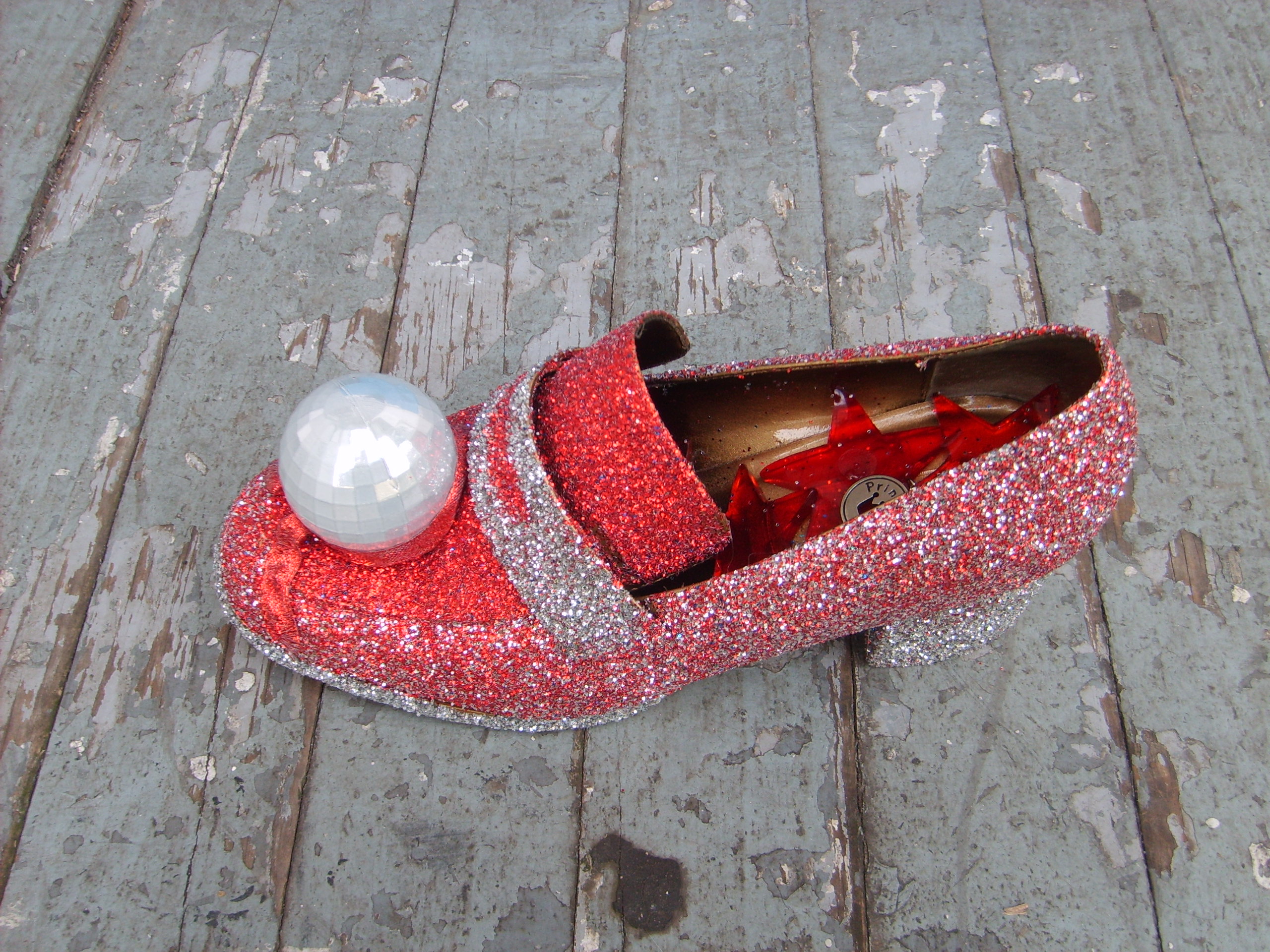
Chaos utilized a relatively new kerosene flambeaux that are not part of the original set made for the old krewes in the late 1800s. The older krewes wouldn’t allow newer krewes to use their original flambeaux, so an ingenious and crafty krewe Captain studied the original flambeaux and created very close copies that work similarly but apparently don’t violate any patent. Chaos was the first parade this season whose floats were made by Royal Artists, who make the some of the best traditional paper mache floats in all of Mardi Gras. Check out Royal Artists’ web site here . Hermes was the first parade on a three parade night, and the floats were made by Royal Artists, giving the parade a traditional paper mache look. Hermes utilizes the older flambeaux. D’Etat goes all out to promote their parade, putting up two different fliers on poles throughout the parade route. D’Etat was one of the very first krewes to toss large numbers of light up beads, one of the biggest trends in Carnival throws. E’tat had a really good looking 3-D krewe cup, the only 3-D cup that I saw all parade season. The 3-D cup uses lenticular technology. Morpheus also used the longer route, following D’Etat. Morpheus is only 8 years old, but they have a traditional look to them. The painting on Morpheus’ floats was different than the other krewes, and I found the style simple but pleasing.
2nd Weekend Parades:
Iris is the oldest of the two all-female parading krewes, Muses being the other. Iris favors children with their throws. Tucks was formed by Loyola college students a few decades ago, and have kept their irreverent attitude. Their unique toilet float has been updated into the King’s float, keeping the porcelain fixture intact.
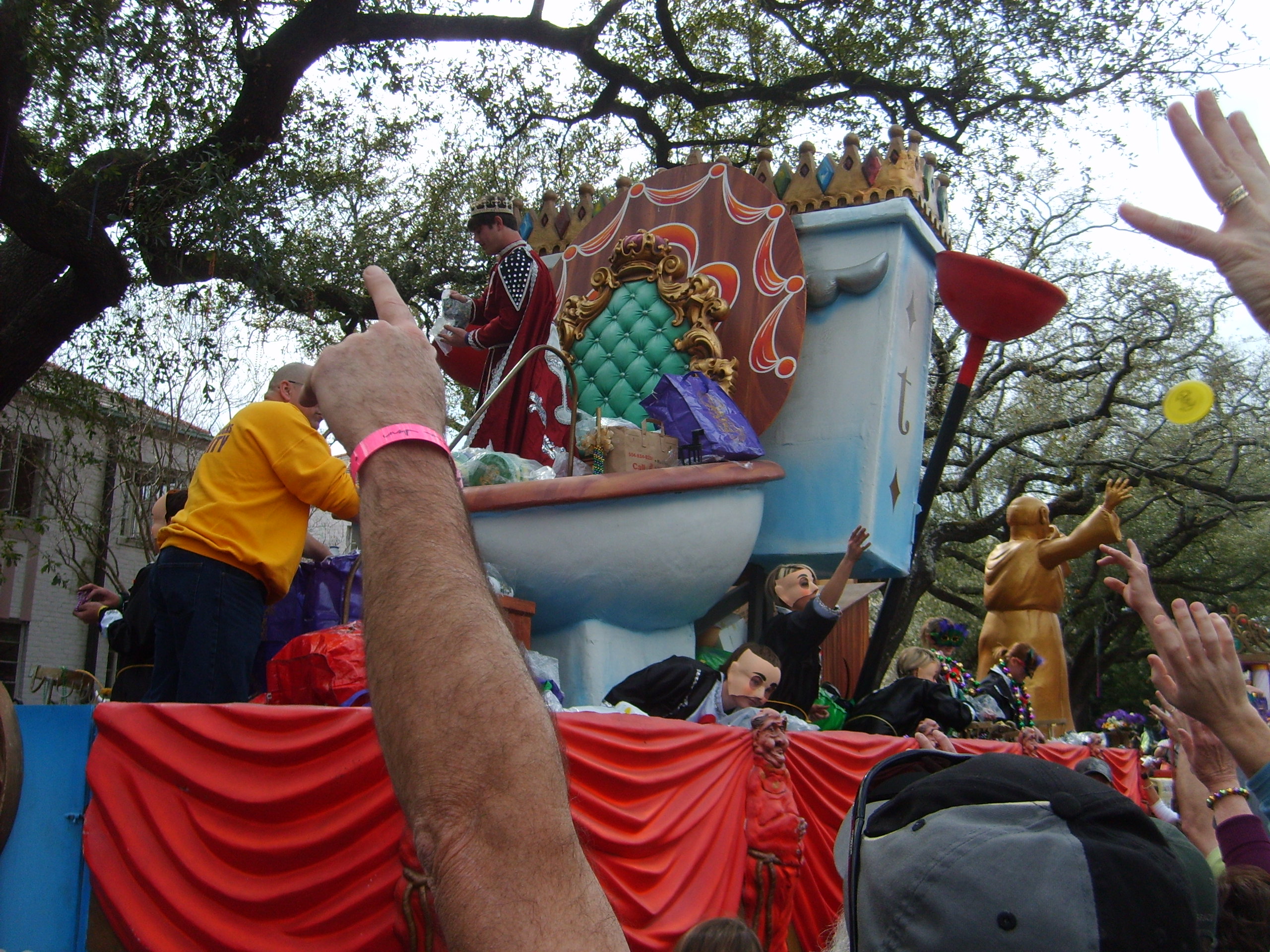
One of the reasons I love Tucks is because I had my own float in Tucks for three years, at a time when Tucks solicited for floats to augment their parade.
Endymion is the biggest of all ‘super krewes’ with over 2,000 riders. Kid Rock was their celebrity king, and before the parade, at the big Endymion block party, Kid Rock reprised his big summer hit, Sweet Home Alabama before a huge crowd. Endymion has the most riders, the biggest floats, the most throws, terrific bands, and the biggest crowds. Endymion began as a neighborhood parade in 1966, and morphed into a super krewe in 1974. They utilize a third type of flambeaux, a propane version.The original flambeaux design burns kerosene, and the system has always leaked. The kerosene is stored in a tank above the head of the flambeaux and gravity carries it down to the burners. I’m not sure who owns these.Okeanos celebrated their 60th anniversary this year. New this year, several krewes that historically started on Napoleon Avenue began their routes at Jefferson and Magazine Streets. Okeanos was the first to try out the route addition. Mid-City was the first parade to use colored foil to decorate their floats, and when the sun is shining, Mid-City’s floats look superlative. Mid-City has an old tradition, the “Greatest Bands in Dixie” contest for the bands that participate in the parade.
Thoth has their own extra long route uptown, as they parade past hospitals and retirement homes. Thoth looked better than usual. In the past they rented their floats from Hermes, and many times, their floats didn’t match the float titles. This year, they had better looking floats that weren’t Hermes.

Bacchus, the original super krewe, was formed in 1968 as a super krewe. To our eyes, Bacchus looked a little smaller in 2009. Bacchus was the first krewe to have a celebrity king each year, and they originated the huge super floats that contain dozens and dozens of riders. Today, there are 4 super krewes in New Orleans- Bacchus, Endymion, Rex, and Orpheus. On the West Bank, Alla qualifies as a super krewe, and in Metairie, Caesar does.
Monday Night Parades:
Proteus began parading in 1881. They use the old wooden wagon chassis and wagon wheels, and the traditional flambeaux they started with over a century ago. I caught a light up seahorse medallion at the parade this year. Proteus is a good looking, traditional paper mache parade built by Royal Artists. The only two parading krewes from the 1800s now are Proteus and Rex. Comus, who began parading in 1857, and Momus, who started in 1872, stopped parading in 1992 after the New Orleans City Council, led by Dorothy Mae Taylor, passed an anti-discrimination ordinance. Proteus stopped parading at this time, but resumed parading in their old Monday night slot in 2000. Orpheus, the super krewe founded by singer/actor Harry Connick, Jr., looked a little less super in 2009. For one thing, after the first few floats, the bands ran out. Super Krewes find enough bands no matter what. While many of their floats were giant, gorgeous creations, many others were ordinary.
Mardi Gras Day Parades:
Zulu celebrated their 100th anniversary in 2009, and to celebrate, their parade, perennially late, was actually early! That is a really big deal for Zulu. I received 5 coconuts after 1/2 of Zulu, which is more than I’ve ever received in over 30 Zulu parades. Today’s Zulu coconuts are improved, 4 of the 5 coconuts I received had the milk and meat removed. If you leave the milk and meat, the coconut often rots. Zulu led off their parade with the Edna Karr High School Band, which was a big switch. Historically, Karr hasn’t been known for leading off Zulu, but in this post-Katrina New Orleans, anything can happen. Rex, King of Carnival, was the first krewe to throw doubloons 50 years ago. Legend has it that Alvin Sharpe, inventor of the Mardi Gras Doubloon, proved the doubloon were safe enough to throw from the floats by tossing a handful at the Rex Captain’s face. When he was unhurt, the doubloon was launched into Mardi Gras throw history. The organization that puts on the Rex parade in called the School of Design. The line of throws thrown by Rex increased in recent years. Historically, Rex threw one type of medallion. This year, they had numerous varieties of logo beads, and two sizes of plush Boeuf Gras. In 2009, Rex didn’t look quite as royal as the King of Carnival should. They too suffered from a bad float/band ratio. Yes, it’s the end of Carnival, but Rex has surmounted this problem before, and I’m surprised and disappointed that they couldn’t obtain even close to enough bands. On St. Charles Avenue a few blocks from Napoleon Avenue, the crowd was lighter than usual. The crowd over the weekend on Bacchus Sunday was noticeably bigger. Yet there is no parade like Rex. They alone have the Boeuf Gras and Jester floats. These floats, along with the Rex King’s float, are the symbols of Carnival in New Orleans the world over.
Mardi Gras Glossary
0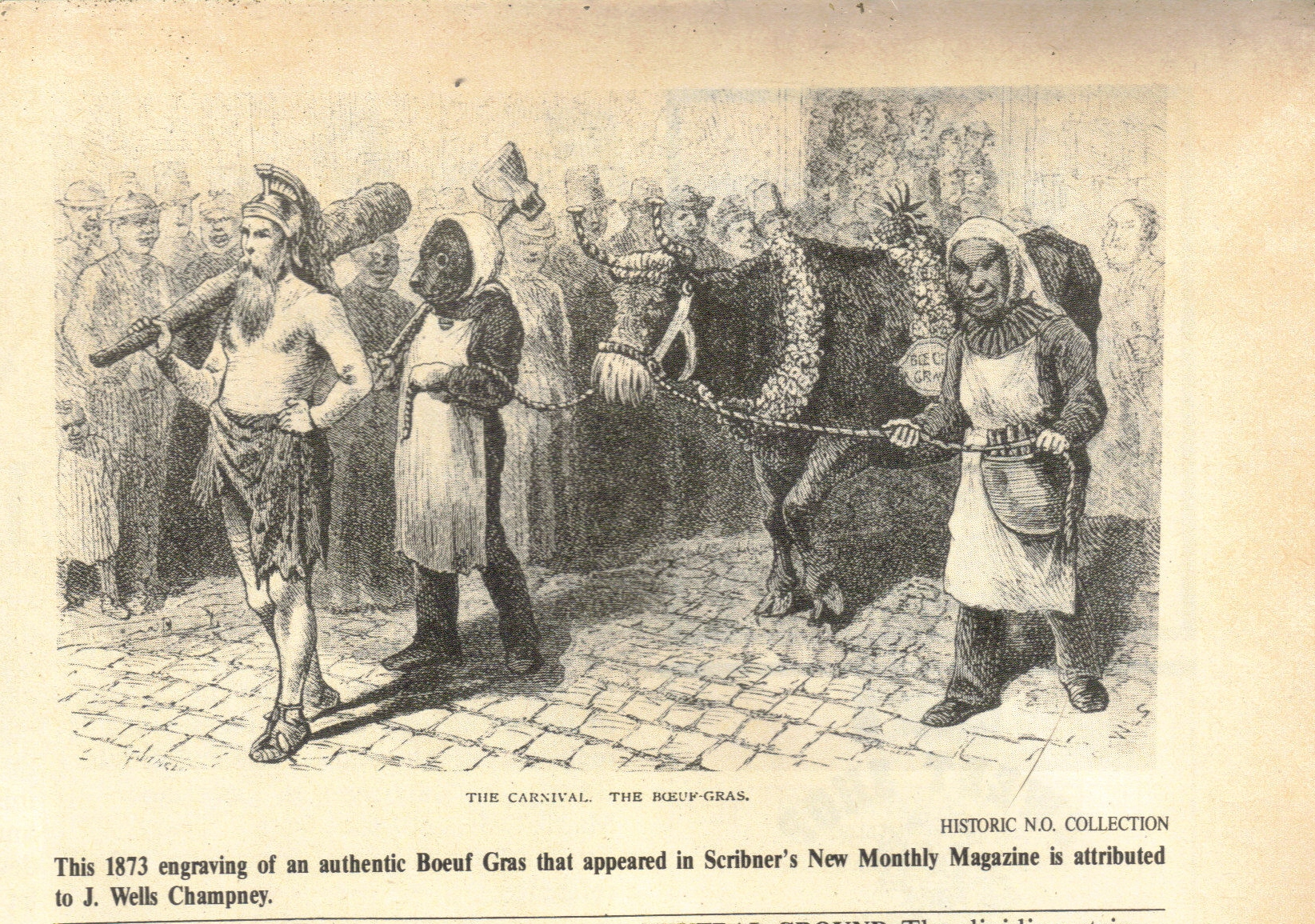 ANODIZED A method of coating a plain aluminum doubloon with a color by dipping the doubloon in an electrolyte bath.
ANODIZED A method of coating a plain aluminum doubloon with a color by dipping the doubloon in an electrolyte bath.
BEIGNET A square, fritter-like doughnut without a hole, fried in hot oil.
BOEUF GRAS “Fattened ox” in French. the Boeuf Gras symbolizes the last meat eaten before the start of Lent.
CARNIVAL The season of merrymaking beginning twelve days after Christmas and ending with Ash Wednesday.
CAFE AU LAIT Coffee prepared with one half hot milk.
DEN A warehouse used to store and build parade floats.
DOUBLOON A type of throw, an aluminum coin with the emblem of the issuing organization embossed on one side and the theme of the parade on the order. 2009 is the 50th anniversary of the Mardi Gras Doubloon, invented by Alvin Sharpe.
FLAMBEAU The traditional device for illuminating Carnival parades, a metal torch fules with naphtha (a petroleum product). Plural- Flambeaux.
KING CAKE A doughnut shaped cake decorated with purple, green and gold icing and/or colored sugar. King Cakes are a major food tradition of Carnival in New Orleans.
KREWE A Universal term for Carnival organizations, coined by Comus in 1857.
MARDI GRAS French for Fat Tuesday, also known as Shrove Tuesday. The culminating day of the Carnival festivities.
MEDALLION A type of throw, a necklace with a pendant bearing a Krewe’s emblem.
NEUTRAL GROUND The dividing strip of ground, usually planted, between the two sides of a large street.
PARISH the Louisiana term for county.
THROW Any trinket tossed from a Carnival parade float to spectators, the most common being plastic beads and plastic cups. Stuffed items are very popular- stuffed animals, swords, figures, etc.
VIEUX CARRE French for “Old Square”, the French Quarter.
